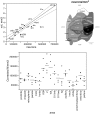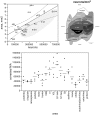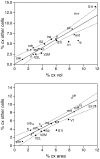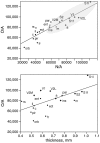Distribution of neurons in functional areas of the mouse cerebral cortex reveals quantitatively different cortical zones
- PMID: 24155697
- PMCID: PMC3800983
- DOI: 10.3389/fnana.2013.00035
Distribution of neurons in functional areas of the mouse cerebral cortex reveals quantitatively different cortical zones
Abstract
How are neurons distributed along the cortical surface and across functional areas? Here we use the isotropic fractionator (Herculano-Houzel and Lent, 2005) to analyze the distribution of neurons across the entire isocortex of the mouse, divided into 18 functional areas defined anatomically. We find that the number of neurons underneath a surface area (the N/A ratio) varies 4.5-fold across functional areas and neuronal density varies 3.2-fold. The face area of S1 contains the most neurons, followed by motor cortex and the primary visual cortex. Remarkably, while the distribution of neurons across functional areas does not accompany the distribution of surface area, it mirrors closely the distribution of cortical volumes-with the exception of the visual areas, which hold more neurons than expected for their volume. Across the non-visual cortex, the volume of individual functional areas is a shared linear function of their number of neurons, while in the visual areas, neuronal densities are much higher than in all other areas. In contrast, the 18 functional areas cluster into three different zones according to the relationship between the N/A ratio and cortical thickness and neuronal density: these three clusters can be called visual, sensory, and, possibly, associative. These findings are remarkably similar to those in the human cerebral cortex (Ribeiro et al., 2013) and suggest that, like the human cerebral cortex, the mouse cerebral cortex comprises two zones that differ in how neurons form the cortical volume, and three zones that differ in how neurons are distributed underneath the cortical surface, possibly in relation to local differences in connectivity through the white matter. Our results suggest that beyond the developmental divide into visual and non-visual cortex, functional areas initially share a common distribution of neurons along the parenchyma that become delimited into functional areas according to the pattern of connectivity established later.
Keywords: cortical development; mouse; neuronal density; numbers of neurons; occipital cortex; visual cortex.
Figures










Similar articles
-
The human cerebral cortex is neither one nor many: neuronal distribution reveals two quantitatively different zones in the gray matter, three in the white matter, and explains local variations in cortical folding.Front Neuroanat. 2013 Sep 2;7:28. doi: 10.3389/fnana.2013.00028. eCollection 2013. Front Neuroanat. 2013. PMID: 24032005 Free PMC article.
-
Variability in neuron densities across the cortical sheet in primates.Brain Behav Evol. 2011;78(1):37-50. doi: 10.1159/000327319. Epub 2011 Jun 17. Brain Behav Evol. 2011. PMID: 21691046 Review.
-
[The functional organization of the spatial structures of the neuronal receptive fields in field 21 of the cat cerebral cortex].Usp Fiziol Nauk. 1995 Jul-Sep;26(3):78-94. Usp Fiziol Nauk. 1995. PMID: 7483756 Russian.
-
The basic nonuniformity of the cerebral cortex.Proc Natl Acad Sci U S A. 2008 Aug 26;105(34):12593-8. doi: 10.1073/pnas.0805417105. Epub 2008 Aug 8. Proc Natl Acad Sci U S A. 2008. PMID: 18689685 Free PMC article.
-
Neocortical grafting to newborn and adult rats: developmental, anatomical and functional aspects.Adv Anat Embryol Cell Biol. 1998;148:1-86. doi: 10.1007/978-3-642-72179-3. Adv Anat Embryol Cell Biol. 1998. PMID: 9670566 Review.
Cited by
-
Bringing Anatomical Information into Neuronal Network Models.Adv Exp Med Biol. 2022;1359:201-234. doi: 10.1007/978-3-030-89439-9_9. Adv Exp Med Biol. 2022. PMID: 35471541
-
The elephant brain in numbers.Front Neuroanat. 2014 Jun 12;8:46. doi: 10.3389/fnana.2014.00046. eCollection 2014. Front Neuroanat. 2014. PMID: 24971054 Free PMC article.
-
Wiring cost and topological participation of the mouse brain connectome.Proc Natl Acad Sci U S A. 2015 Aug 11;112(32):10032-7. doi: 10.1073/pnas.1420315112. Epub 2015 Jul 27. Proc Natl Acad Sci U S A. 2015. PMID: 26216962 Free PMC article.
-
Volumetric Ca2+ Imaging in the Mouse Brain Using Hybrid Multiplexed Sculpted Light Microscopy.Cell. 2019 May 2;177(4):1050-1066.e14. doi: 10.1016/j.cell.2019.03.011. Epub 2019 Apr 11. Cell. 2019. PMID: 30982596 Free PMC article.
-
FLRTing Neurons in Cortical Migration During Cerebral Cortex Development.Front Cell Dev Biol. 2020 Sep 17;8:578506. doi: 10.3389/fcell.2020.578506. eCollection 2020. Front Cell Dev Biol. 2020. PMID: 33043013 Free PMC article. Review.
References
LinkOut - more resources
Full Text Sources
Other Literature Sources
Medical

